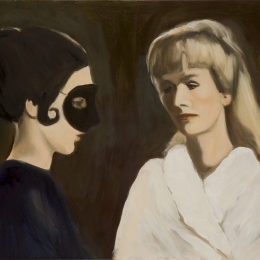art or business
Kupcsik Adrián, Szépfalvi Ágnes
On 12 December, the kArton Gallery opens an exhibition of the latest works of Adrián Kupcsik and Ágnes Szépfalvi. Making the most of the two separate spaces of the Gallery, we have set up two chamber exhibitions, rather than a thematic show. Once again, we reencounter Szépfalvi’s familiar female figures, who step out of film scenes, in uncomfortable, vulnerable situations. The artist, seeking proper explanation for the bizarre snapshot-like scenes, paraphrases Truffaut, the famous French film director: Since, however much I would like to, I never manage to paint a happy picture, everything must appear strange and then we’ll see what comes of it”.
Instead of the usual colourful, decorative “Szépfalvi-world”, the exhibition at the kArton places greater emphasis on the artist’s black and white drawings. Although he had done charcoal drawings earlier, he intended those to be the “test prints” of his larger paintings. Recently, drawings have been given a greater role; they have taken on a life of their own. The cinematic scenes are images frozen in time which appear almost iconic and which could also be read as corresponding to archetypal examples of female roles.
Viewed from a certain perspective, Adrián Kupcsik’s work also relates to archetypal images. The pieces displayed on the walls of the Gallery – referred to by Kupcsik as “diagram still lifes” – are more or less in direct opposition to his earlier thematic. He has created seemingly archetypal images that are painted on wood and allude to a method of representation used in the early Renaissance as well as certain painting problematics, while also making a parody. He adds to the five senses, which appear in an objectified form, the less-definable sixth sense (though the form/at characteristic of the latter can be swapped in the picture with an object associated with one of the other senses). The story of 21st century painting is modelled by a diagram built from spoons, slices of bread and kitchenware. “Adrián Kupcsik’s works of the past few years pass a harsh judgement on the tradition of the imagination and make the statement that the means and symbol system of composition and representation are not to be found in the technological images of reality, but in the head of the artists, who, in full awareness of their preparedness, establish the methodological frameworks which give meaning to the freedom of imagination,” writes Zsolt Petrányi in 2005. These lines, however, are even more characteristic of his works of 2007. Defying allegorical interpretations in the classic sense of the word, Kupcsik constructs systems of explanations whose interpretation is left completely to the viewer.

